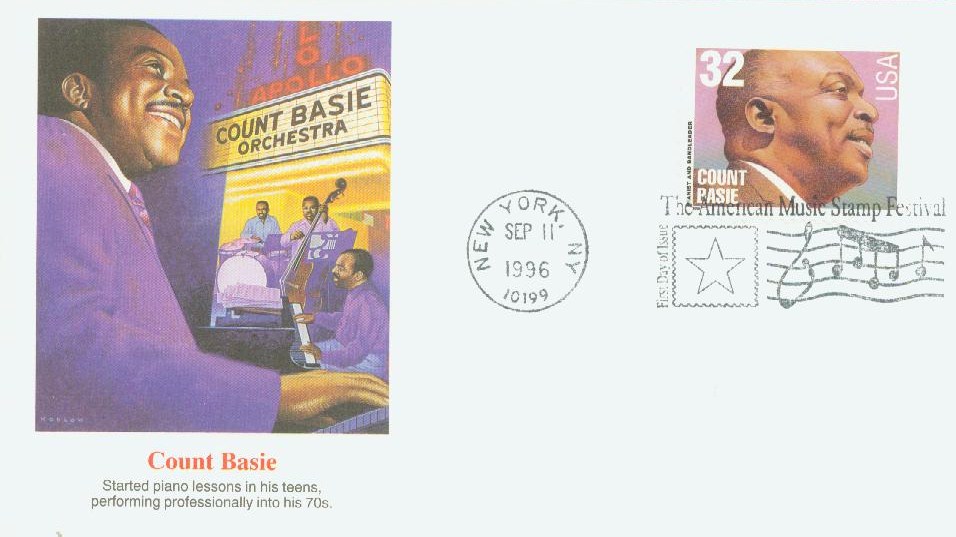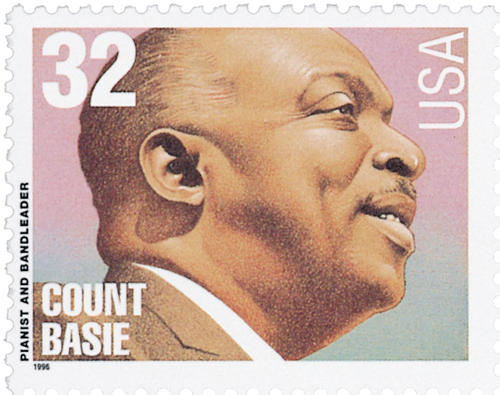
# 3096 - 1996 32c Big Band Leaders: Count Basie
US #3096
1996 Count Basie
- Part of set featuring four legendary Big Bank Leaders
- 7th pane in the Legends of Music series
- Stamps were issued on same day as Songwriters stamps in same series
Stamp Category: Commemorative
Set: Big Band Leaders, American Music series
Value: 32¢, First-Class mail rate
First Day of Issue: September 11, 1996
First Day City: New York, New York
Quantity Issued: 23,025,000
Printed by: Ashton-Potter (USA) Ltd.
Printing Method: Lithographed
Format: Panes of 20 (4 across, 5 down) from plates of 120 (12 across, 10 down)
Perforations: 11.1 x 11
Why the stamp was issued: The five stamps in the Big Band Leaders set honor talented individuals who contributed to the sound of Big Band music. They include Count Basie, Tommy and Jimmy Dorsey, Glenn Miller, and Benny Goodman.
About the stamp design: The portraits of the four big band leaders were made by Bill Nelson, who works in colored pencils on recycled charcoal paper. He had previously designed album covers for big band recordings compiled by Time-Life Records.
First Day City: The set of five Big Band Leaders stamps was dedicated at Shubert Alley in New York City. The Songwriters stamps from the same series were issued at the same time. It kicked off the US Postal Service’s American Music Stamp Festival 1996. Family members of the men featured on the stamps were present at the ceremony.
About the Legends of American Music Series: The Legends of American Music Series debuted on January 8, 1993, and ran until September 21, 1999. More than 90 artists are represented from all styles of music: rock ‘n’ roll, rhythm and blues, country and western, jazz and pop, opera and classical, gospel and folk. In addition to individual singers and Broadway musicals, subjects include band leaders, classical composers, Hollywood songwriters and composers, conductors, lyricists, and more. The Legends of American Music Series was a huge advancement for diversity because it honored many Black and female artists.
History the stamp represents: The success of the Benny Goodman Orchestra in 1935 led to the formation of other big bands led by such talented individuals as Count Basie, Tommy and jimmy Dorsey, and Glenn Miller.
Basie’s mother taught him to play piano when he was young and he began performing in his hometown as a young teenager. He learned to accompany the silent films that played at the local theatre. Basie preferred drums at first, but by the time he was 15 he realized his true talent was on the piano.

By the time Basie was in his early 20s, he was touring with vaudeville acts and traveled to the jazz centers in Kansas City, St. Louis, and Chicago. In 1928, he got his first taste of the big band sound and joined a Kansas City band under the direction of Bennie Moten the next year.
The band, with Basie’s musical contributions, began playing a style of music that soon became known as swing. After playing with Moten’s band for a number of years, Basie formed his own. One night they were broadcasting on a local radio station and had some time to fill at the end of the program. The group began improvising, and that session produced a song Basie called “One O’Clock Jump.” It became the band’s signature songs for many years.

In 1936, Basie got the nickname “Count” from a radio announcer in Kansas City. At the time, he went by Bill Basie, and the announcer said that was too ordinary of name. Citing names like Earl Hines and Duke Ellington, the announcer said he’d call Basie “Count,” and the name stuck.
By 1936, his band was called Count Basie and His Barons of Rhythm. They became known for their strong rhythm section and for using two tenor saxophones instead of just one. Other bands were soon copying the sound. That October, the band recorded some of their music. The producer later called it “the only perfect, completely perfect recording session I’ve ever had anything to do with.”

Basie’s band continued until after World War II, when it seemed big band music had gone out of style. After disbanding his large group, he began touring with smaller bands. In the late 1950s, the Count made his first tour of Europe. Jazz was popular there, and his music was well received. He even played for Queen Elizabeth II.
Count Basie was able to continue playing his piano and leading bands for decades. He played for such great soloists as Ella Fitzgerald, Frank Sinatra, and Tony Bennett. During his career the Count earned nine Grammy awards and made a permanent mark on American music. He passed away on April 26, 1984, in Hollywood, Florida. The Count Basie Theatre in Red Bank is one of several places named in his honor.

Click here for video of Basie and his band performing a number of songs.
Click here for more music stamps.
US #3096
1996 Count Basie
- Part of set featuring four legendary Big Bank Leaders
- 7th pane in the Legends of Music series
- Stamps were issued on same day as Songwriters stamps in same series
Stamp Category: Commemorative
Set: Big Band Leaders, American Music series
Value: 32¢, First-Class mail rate
First Day of Issue: September 11, 1996
First Day City: New York, New York
Quantity Issued: 23,025,000
Printed by: Ashton-Potter (USA) Ltd.
Printing Method: Lithographed
Format: Panes of 20 (4 across, 5 down) from plates of 120 (12 across, 10 down)
Perforations: 11.1 x 11
Why the stamp was issued: The five stamps in the Big Band Leaders set honor talented individuals who contributed to the sound of Big Band music. They include Count Basie, Tommy and Jimmy Dorsey, Glenn Miller, and Benny Goodman.
About the stamp design: The portraits of the four big band leaders were made by Bill Nelson, who works in colored pencils on recycled charcoal paper. He had previously designed album covers for big band recordings compiled by Time-Life Records.
First Day City: The set of five Big Band Leaders stamps was dedicated at Shubert Alley in New York City. The Songwriters stamps from the same series were issued at the same time. It kicked off the US Postal Service’s American Music Stamp Festival 1996. Family members of the men featured on the stamps were present at the ceremony.
About the Legends of American Music Series: The Legends of American Music Series debuted on January 8, 1993, and ran until September 21, 1999. More than 90 artists are represented from all styles of music: rock ‘n’ roll, rhythm and blues, country and western, jazz and pop, opera and classical, gospel and folk. In addition to individual singers and Broadway musicals, subjects include band leaders, classical composers, Hollywood songwriters and composers, conductors, lyricists, and more. The Legends of American Music Series was a huge advancement for diversity because it honored many Black and female artists.
History the stamp represents: The success of the Benny Goodman Orchestra in 1935 led to the formation of other big bands led by such talented individuals as Count Basie, Tommy and jimmy Dorsey, and Glenn Miller.
Basie’s mother taught him to play piano when he was young and he began performing in his hometown as a young teenager. He learned to accompany the silent films that played at the local theatre. Basie preferred drums at first, but by the time he was 15 he realized his true talent was on the piano.

By the time Basie was in his early 20s, he was touring with vaudeville acts and traveled to the jazz centers in Kansas City, St. Louis, and Chicago. In 1928, he got his first taste of the big band sound and joined a Kansas City band under the direction of Bennie Moten the next year.
The band, with Basie’s musical contributions, began playing a style of music that soon became known as swing. After playing with Moten’s band for a number of years, Basie formed his own. One night they were broadcasting on a local radio station and had some time to fill at the end of the program. The group began improvising, and that session produced a song Basie called “One O’Clock Jump.” It became the band’s signature songs for many years.

In 1936, Basie got the nickname “Count” from a radio announcer in Kansas City. At the time, he went by Bill Basie, and the announcer said that was too ordinary of name. Citing names like Earl Hines and Duke Ellington, the announcer said he’d call Basie “Count,” and the name stuck.
By 1936, his band was called Count Basie and His Barons of Rhythm. They became known for their strong rhythm section and for using two tenor saxophones instead of just one. Other bands were soon copying the sound. That October, the band recorded some of their music. The producer later called it “the only perfect, completely perfect recording session I’ve ever had anything to do with.”

Basie’s band continued until after World War II, when it seemed big band music had gone out of style. After disbanding his large group, he began touring with smaller bands. In the late 1950s, the Count made his first tour of Europe. Jazz was popular there, and his music was well received. He even played for Queen Elizabeth II.
Count Basie was able to continue playing his piano and leading bands for decades. He played for such great soloists as Ella Fitzgerald, Frank Sinatra, and Tony Bennett. During his career the Count earned nine Grammy awards and made a permanent mark on American music. He passed away on April 26, 1984, in Hollywood, Florida. The Count Basie Theatre in Red Bank is one of several places named in his honor.

Click here for video of Basie and his band performing a number of songs.
Click here for more music stamps.












